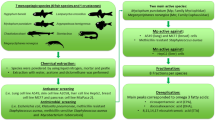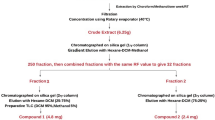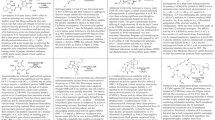Abstract
REFERENCES to the biological properties of marine organisms date back to antiquity1. For example, hieroglyphics on the tomb of the Egyptian Pharaoh Ti (approximately 2700 BC) described the poisonous puffer fish Tetraodon stellatus. Perhaps the earliest recorded use of a marine organism in primitive medical practice occurred when the Roman, Plinius Secundus (AD 29–79), recommended that the sting unit of the stingray be ground up and used for treatment of toothache and in obstetrics. The first modern pharmacological and chemical studies of a substance from a marine animal probably involved tetrodotoxin from the poisonous puffer fish (for leading references see refs. 2 and 3). In recent years, extracts from certain sponges and coelenteratas have been shown to have antibiotic properties4–8. There have also been indications that marine invertebrates produce various other potentially medically useful components9–11. Most important from the standpoint of cancer chemotherapy have been observations that starfish meal12–14 and the peanut worm Bonellia fulginosa15,16 and that partially purified material from certain sea cucumbers [Echinodermata] have antitumour activity against sarcoma-180 and Krebs-2 ascites tumour10,17–19. Also certain clam18 (Mollusca) extracts and material from oysters have antitumour properties9–11.
This is a preview of subscription content, access via your institution
Access options
Subscribe to this journal
Receive 51 print issues and online access
$199.00 per year
only $3.90 per issue
Buy this article
- Purchase on Springer Link
- Instant access to full article PDF
Prices may be subject to local taxes which are calculated during checkout
Similar content being viewed by others
References
Halstead, B. W., Poisonous and Venomous Marine Animals of the World, 1, 2 (US Government Printing Office, Washington, DC, 1965, 1967).
Woodward, R. B., and Gougoutas, J. Z., J. Amer. Chem. Soc., 86, 5030 (1964).
Goto, T., Kishi, Y., Takahashi, S., and Hirata, Y., Tetrahedron, 21, 2059 (1965).
Nigrelli, R. F., Jakowska, S., and Calventi, I., Zoologica, 44, 173 (1959).
Jakowska, S., and Nigrelli, R. F., Ann. NY Acad. Sci., 90, 913 (1960).
Burkholder, P. R., and Burkholder, L. M., Science, 127, 1174 (1958).
Ciereszko, L. S., Sifford, D. H., and Weinheimer, A. J., Ann. NY Acad. Sci., 90, 917 (1960).
Ciereszko, L. S., Trans. NY Acad. Sci., 24, 502 (1962).
Marderosian, A. H. D., J. Pharm. Sci., 58, 1 (1969).
Nigrelli, B. F., Stempien, M. F., Ruggieri, G. D., Ligouri, V. R., and Cecil, J. T., Fed. Proc., 26, 1197 (1967).
Sigel, M. M., Conf. on Food-Drugs from the Sea, Kingston, Rhode Island, August, 1969.
Whitson, D., and Titus, H. W., Bull. Bingham Oceanog. Coll., 9, 24 (1945).
Lee, C. F., US Fish Wildlife Service, Fish Leaflet 391 (1951).
Heilbrunn, L. V., Chaet, A. B., Dunn, A., and Wilson, W. L., Biol. Bull., 106, 158 (1954).
Baltzer, F., Mitt. Naturf. Ges. Bern., 8, 98 (1925).
Baltzer, F., Rev. Suisse Zool., 32, 87 (1925).
Friess, S. L., Standaert, F. G., Whitcomb, E. R., Nigrelli, R. F., Chanley, J. D., and Sobotka, H., Ann. NY Acad. Sci., 90, 893 (1960).
Schmeer, M. R., and Huala, C. V., Ann. NY Acad. Sci., 118, 605 (1965).
Li, C. P., Prescott, B., and Jahnes, W. B., Proc. Soc. Exp. Biol. Med., 109, 534 (1962).
Pettit, G. R., Hartwell, J. L., and Wood, H. B., Cancer Res., 28, 2168 (1968).
Author information
Authors and Affiliations
Rights and permissions
About this article
Cite this article
PETTIT, G., DAY, J., HARTWELL, J. et al. Antineoplastic Components of Marine Animals. Nature 227, 962–963 (1970). https://doi.org/10.1038/227962a0
Received:
Issue Date:
DOI: https://doi.org/10.1038/227962a0
This article is cited by
-
Influence of symbiont-produced bioactive natural products on holobiont fitness in the marine bryozoan, Bugula neritina via protein kinase C (PKC)
Marine Biology (2016)
-
Complete NMR assignments of undegraded asterosaponins from Asterias amurensis
Archives of Pharmacal Research (2014)
-
Sensitizing T-lymphocytes for adoptive immunotherapy by vaccination with wild-type or cytokine gene-transduced melanoma
Annals of Surgical Oncology (1997)
Comments
By submitting a comment you agree to abide by our Terms and Community Guidelines. If you find something abusive or that does not comply with our terms or guidelines please flag it as inappropriate.



